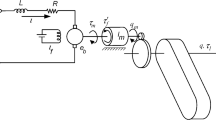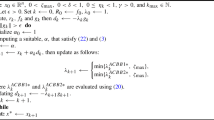Abstract
The adaptive approximation control is a powerful tool for controlling robotic systems with unmodeled dynamics. The local (partitioned) approximation-based adaptive control includes representation of the uncertain matrices and vectors in the robot model as finite combinations of basis functions. Update laws for the weighting matrices are obtained by the Lyapunov-like design. However, one of the inherent limitations of this category of approximation is curse dimensionality associated with the approximation of uncertain matrix. There are three possible representations for the approximation of the uncertain matrix: Kronecker product, sparse matrices, and GL operator. Both Kronecker product and sparse matrices can grow exponentially with the dimension of the target matrix, whereas GL operator can grow linearly but without the use of conventional operations of matrices. In light of the above, this paper proposes a simple representation for the approximation of the uncertain matrix. The proposed representation is directly linear with respect to the dimension of the target matrix using the conventional operations of matrices. A comparative study is performed to all previously investigated representations, including the proposed representation in view of control law, adaptive law and the order of approximation for robotic manipulators in free space. Two case studies are simulated which are: two-link manipulator and 6-link biped robots during the single support phase. The results show that for low dimension robotic manipulators, all representations can be conducted equivalently. There is no large difference in view of simulation time, whereas for higher degrees of freedom robots the Gl operator and the proposed representation are superior in view of simulation time.





Similar content being viewed by others
References
Farrell JA, Polycarpou MM (2006) Adaptive approximation based control: unifying neural, fuzzy and traditional adaptive approximation approach. Wiley, Hoboken
Loannou P, Fidan B (2006) Adaptive control tutorial. SIAM, Philadelphia
Craig JJ (1988) Adaptive control of mechanical manipulators. Addison-Wesley Publishing company Inc, New York
Spong MW, Vidyasagar M (1989) Robot dynamics and control. Wiley, New York
Slotine JJE, Li W (1991) Applied nonlinear control. Prentice-Hall, Inc, New Jersey
Zhu W-H (2010) Virtual decomposition control: toward hyper degrees of freedom robots. Springer, Berlin
Song YD (1994) Adaptive motion tracking control of robot manipulators-non-regressor based approach. Proc IEEE Int Conf Robot Autom 4:3008–3013
Lu WS, Meng QH (1991a) Recursive computation of manipulator regressor and its application to adaptive motion control of robot. In: IEEE conference on communication, computation and signal processing, pp 170–173
Kawasaki H, Bito T, Kanzaki K (1996) An efficient algorithm for model-based adaptive controller of robot manipulators. IEEE Trans Robot Autom 12(3):496–501
Yang JH (1999) Adaptive tracking control for manipulators with only position feedback. In: IEEE Canadian conference on electrical and computer engineering, pp 1740–1745
Qu Z, Dorsey J (1991) Robust tracking control of robots by a linear feedback law. IEEE Trans Autom Control 36(9):1081–1084
Park JS, Jiang YA, Hesketh T, Clements DJ (1994) Trajectory control of manipulators using adaptive sliding mode control. In: Proceedings of IEEE, Southeastcon, pp 142–146
Yuan J, Stepanenko Y (1993) Adaptive PD control of flexible joint robots without using the high-order regressor. In: Proceedings of the 36th Midwest symposium on circuits and systems, pp 389–393
Su C-Y, Stepanenko Y (1996) Adaptive control for constrained robots without using regressor. In: IEEE international conference on robotics and automation, pp 264–269
Huang A-C, Chien M-C (2010) Adaptive control of robot manipulators: a unified regressor-free approach. World Scientific Publishing Co. Pte. Ltd, Singapore
Cong S, Liang Y, Shang W (2008) Function approximation-based sliding mode adaptive control for time-varying uncertain nonlinear systems. Nonlinear Dyn 54(5):223–230
Liang W, Chen H-Y, Tsu Y-T (2009) FAT-based adaptive sliding mode control for a piezoelectric-actuated system. In: IEEE international conference on control and automation, pp 848–853
Ci C, Zhi L, Yun Z (2015) Fuzzy approximation based adaptive control for multiple robotic arms with input hysteresis nonlinearities. In: Proceedings of the 34th Chinese control conference, China, pp 5948–5952
Ahmadi B, Nourisola H (2015) Robust adaptive \(H_\infty \) controller based on hybrid genetic wavelet kernel principal component or nonlinear uncertain systems. Majlesi J Electr Eng 9(4):13–21
Beuschel M (2000) Nonlinear function approximators. In: Schroeder D (ed) Intelligent observer and control design for nonlinear systems. Springer, Berlin
Lewis FL, Yesildirek A, Liu K (1995) Neural net robot controller: structure and stability proofs. J Intell Robot Syst 13:1–23
Lewis FL, Liu K, Yesildirek A (1995) Neural net robot controller with guaranteed tracking performance. IEEE Trans Neural Netw 6(3):703–716
Lewis FL, Yesildirek A, Liu K (1996) Multilayer neural net robot controller with guaranteed tracking performance. IEEE Trans Neural Netw 7(2):1–12
Liu J (2013) Radial basis function (RBF) neural network control for mechanical systems: design, analysis and Matlab simulation. Tsinghua University Press, Beijing
Li Y-X, Yang G-H (2016) Approximation-based adaptive neural output feedback control for a class of uncertain switched stochastic nonlinear systems with average dwell time condition. Neurocomputing 186:160–169
Al-Shuka HFN, Corves B, Zhu W-H (2014) Function approximation technique-based adaptive virtual decomposition control of a serial-chain manipulator. Robotica 32(3):375–399
Al-Shuka HFN (2014) Modeling, adaptive control and walking pattern generators of biped robot. PhD Dissertation, IGM, RWTH Aachen University, Germany
Ge SS, Lee TH, Harris CJ (1998) Adaptive neural network control of robotic manipulators. World Scientific Publishing Co. Pte. Ltd, Singapore
Faires JD, Burden RL (2002) Numerical methods, 3rd edn. Brooks Cole, Pacific Groove
Ignacio J, Matinez M (2013) A proof of the Ge-Lee statement on the inertia regressor of robot manipulators. Robotica 31(01):55–59
Al-Shuka HFN, Corves B, Zhu W-H, Vanderborghtc B (2015) Multi-level control of zero-moment-based humanoid biped robots: a review. Robotica 34(11):2440–2466
Al-Shuka HFN, Allmendinger F, Corves B, Zhu W-H (2014) Modeling, stability and walking pattern generators of biped robots: a review. Robotica 32:907–934
Author information
Authors and Affiliations
Corresponding author
Rights and permissions
About this article
Cite this article
Al-Shuka, H.F.N. On local approximation-based adaptive control with applications to robotic manipulators and biped robots. Int. J. Dynam. Control 6, 339–353 (2018). https://doi.org/10.1007/s40435-016-0302-6
Received:
Revised:
Accepted:
Published:
Issue Date:
DOI: https://doi.org/10.1007/s40435-016-0302-6




